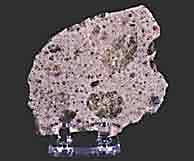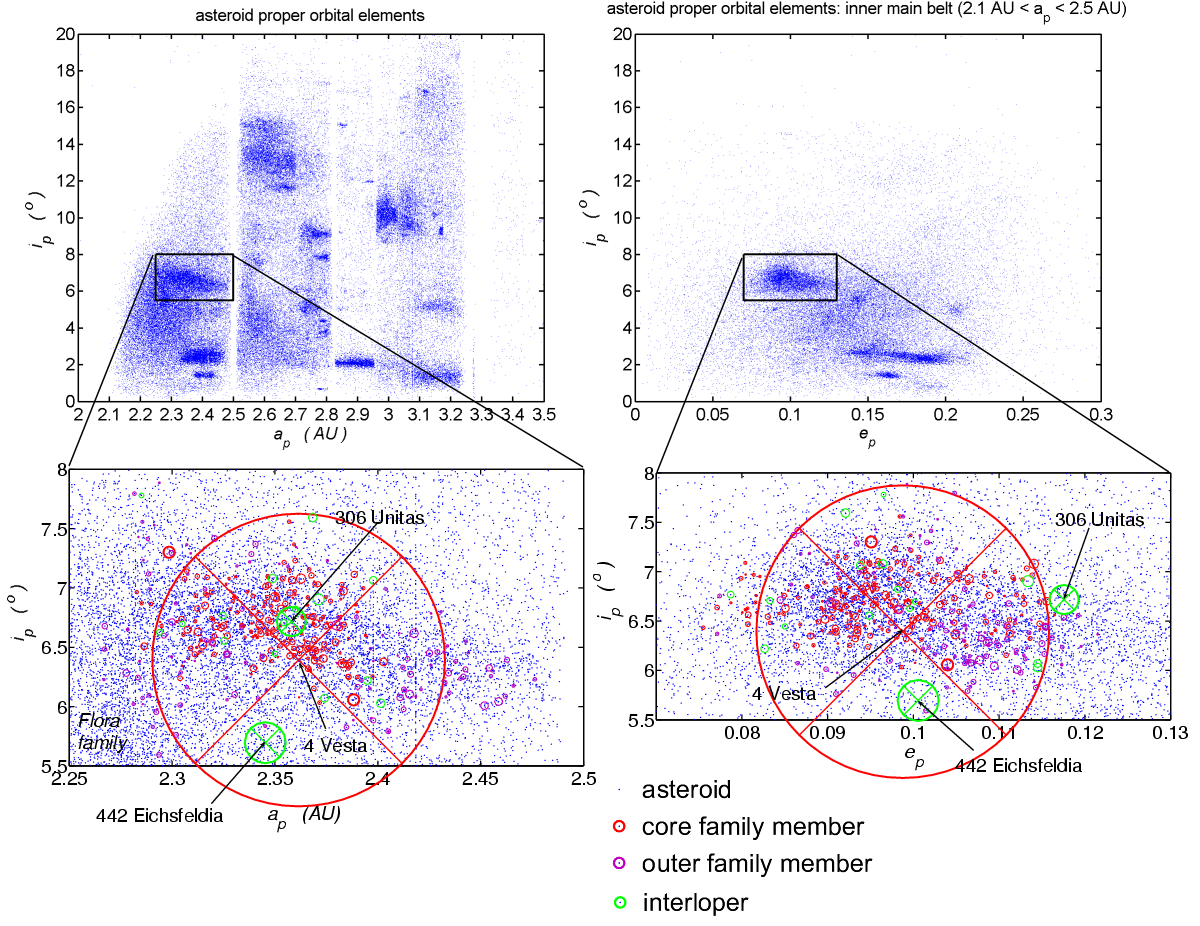|
Diogenite
Diogenites are a group of the HED meteorite clan, a type of achondritic stony meteorites. Origin and composition Diogenites are currently believed to originate from deep within the crust of the asteroid 4 Vesta, and as such are part of the HED meteorite clan. There are about 40 distinct members known. Diogenites are composed of igneous rocks of plutonic origin, having solidified slowly enough deep within Vesta's crust to form crystals which are larger than in the eucrites. These crystals are primarily magnesium-rich orthopyroxene, with small amounts of plagioclase and olivine. Name Diogenites are named for Diogenes of Apollonia, an ancient Greek philosopher who was the first to suggest an outer space origin for meteorites. See also * Glossary of meteoritics * Vesta family The Vesta family (adj. ''Vestian''; ) is a family of asteroids. The cratering family is located in the inner asteroid belt in the vicinity of its namesake and principal body, 4 Vesta. It is one of the ... [...More Info...] [...Related Items...] OR: [Wikipedia] [Google] [Baidu] |
4 Vesta
Vesta (minor-planet designation: 4 Vesta) is one of the largest objects in the asteroid belt, with a mean diameter of . It was discovered by the German astronomer Heinrich Wilhelm Matthias Olbers on 29 March 1807 and is named after Vesta, the virgin goddess of home and hearth from Roman mythology. Vesta is thought to be the second-largest asteroid, both by mass and by volume, after the dwarf planet Ceres, though in volume it overlaps with the uncertainty in the measurements of 2 Pallas.Marsset, M., Brož, M., Vernazza, P. et al. The violent collisional history of aqueously evolved (2) Pallas. Nat Astron 4, 569–576 (2020). https://doi.org/10.1038/s41550-019-1007-5 Measurements give it a nominal volume only slightly larger than that of Pallas (about 5% greater, which is the magnitude of the uncertainties in measurement), but it is 25% to 30% more massive. It constitutes an estimated 9% of the mass of the asteroid belt. Vesta is the only known remaining rocky protoplanet (with a ... [...More Info...] [...Related Items...] OR: [Wikipedia] [Google] [Baidu] |
HED Meteorite
HED meteorites are a clan (subgroup) of achondrite meteorites. HED stands for "howardite–eucrite–diogenite". These achondrites came from a differentiated parent body and experienced extensive igneous processing not much different from the magmatic rocks found on Earth and for this reason they closely resemble terrestrial igneous rocks. Classification HED meteorites are broadly divided into: * Howardites * Eucrites * Diogenites Several subgroups of both eucrites and diogenites have been found. The HED meteorites account for about 5% of all falls, which is about 60% of all achondrites. Origin No matter their composition all these types of meteorite are thought to have originated in the crust of the asteroid Vesta. According to this theory the differences of composition are due to their ejection at different moments in the geologic history of Vesta. Their crystallization ages have been determined to be between 4.43 and 4.55 billion years from radioisotope ratios. HED meteorit ... [...More Info...] [...Related Items...] OR: [Wikipedia] [Google] [Baidu] |
Johnstown (meteorite)
Johnstown is a home rule municipality in Weld and Larimer counties in the U.S. state of Colorado. The population was 9,887 at the 2010 United States Census. History The Town of Johnstown began with the vision of Harvey J. Parish before its platting in 1902. The town was named for Parish's son. The town was incorporated in 1907. A meteorite fall in the adjacent former town of Elwell on the afternoon of 6 July 1924, became known as the Johnstown meteorite. It was notable with a number of large pieces of the broken-up asteroid recovered, including one of that impacted into the Earth to a depth of . The meteorite fell during an outdoor funeral service with more than 200 people attending who witnessed the event or heard the several stones falling. The meteorite is classified as an "achondrite stony meteorite of the diogenite class in the HED group" of meteorites that are believed to have hived off of the asteroid Vesta approximately one billion years ago. Geography Johnstow ... [...More Info...] [...Related Items...] OR: [Wikipedia] [Google] [Baidu] |
Vesta Family
The Vesta family (adj. ''Vestian''; ) is a family of asteroids. The cratering family is located in the inner asteroid belt in the vicinity of its namesake and principal body, 4 Vesta. It is one of the largest asteroid families with more than 15,000 known members and consists of mostly bright V-type asteroids, so-called "vestoids". Characteristics The Vestian asteroids consist of 4 Vesta, the second-most-massive of all asteroids (mean diameter of 530 km), and many small asteroids below 10 km diameter. The brightest of these, 1929 Kollaa and 2045 Peking, have an absolute magnitude of 12.2, which would give them a radius of about 7.5 km assuming the same high albedo as 4 Vesta. The family originated from an impact on asteroid 4 Vesta, with the giant south-polar crater the likely impact site. The family are thought to be the source of the HED meteorites. The Vesta family also includes a few J-type asteroids (related to the V-type), which are thought to have ... [...More Info...] [...Related Items...] OR: [Wikipedia] [Google] [Baidu] |
Glossary Of Meteoritics
This is a glossary of terms used in meteoritics, the science of meteorites. # * 2 Pallas – an asteroid from the asteroid belt and one of the likely parent bodies of the CR meteorites. * 4 Vesta – second-largest asteroid in the asteroid belt and likely source of the HED meteorites. * 221 Eos – an asteroid from the asteroid belt and one of the likely parent bodies of the CO meteorites. * 289 Nenetta – an asteroid from the asteroid belt and one of the likely parent bodies of the angrites. * 3103 Eger – an asteroid from the asteroid belt and one of the likely parent bodies of the aubrites. * 3819 Robinson – an asteroid from the asteroid belt and one of the likely parent bodies of the angrites. * IA meteorite – an iron meteorite group now part of the IAB group/complex. * IAB meteorite – an iron meteorite and primitive achondrite of the IAB group/complex. * IB meteorite – an iron meteorite group now part of the IAB group/complex. * IC meteorite – an ... [...More Info...] [...Related Items...] OR: [Wikipedia] [Google] [Baidu] |



